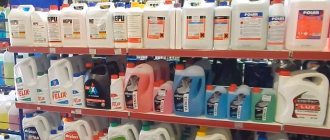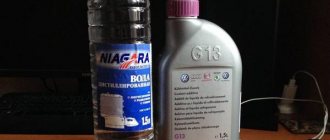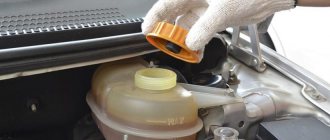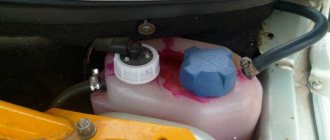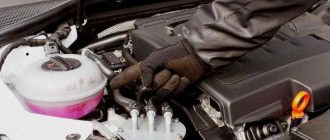04/23/2021 55 336 Cooling system
Author: Ivan Baranov
As you know, coolant is an important consumable element in the system of any car. Therefore, the choice of refrigerant is a priority when replacing it. Today we will tell you how to determine whether “Tosol” or antifreeze is filled, and what are the differences between these substances.
Many experienced car enthusiasts know that optimal and efficient operation of a vehicle’s engine is ensured by high-quality coolant filled in. If the consumable material is really good, then it can extend the service life of engine components, as well as ensure their normal operation.
Antifreeze and antifreeze from various manufacturers, distilled water
What to do if you don’t know what kind of coolant (hereinafter referred to as coolant) is in your car? Determining this is not as easy as it seems at first glance.
[Hide]
Differences from antifreeze
Antifreezes are liquids that do not freeze at subzero temperatures. Coolant is poured into the vehicle's cooling system. Also, these mixtures have lubricating properties and protect metal parts from corrosion.
Antifreeze is a coolant that helps protect a car engine from harmful overheating. The boiling point of such a coolant is above 120 degrees Celsius. These liquids freeze only in critical frosts. Even an average quality mixture does not lose its properties at temperatures of -38 and below. Antifreeze allows you to use your car at any time of the year, no matter whether it is summer or winter. As for antifreeze, from a chemical point of view it is the same antifreeze, only domestic. By the way, in no other country, except for the USSR, did there exist a division of coolants into such classifications. This is a purely Soviet development.
Signs of antifreeze in oil
The malfunction will make itself known by showing characteristic signals. Signs of antifreeze getting into the oil are:
Maximum engine oil level An increase in the level in the lubrication system, while simultaneously reducing the volume of coolant. If the expansion tank is rapidly emptying and there is no antifreeze leak, look at the dipstick; most likely the level will be above the MAX.
A change in color from light brown to dark will indicate an admixture of antifreeze. Especially if the lubricant has recently been changed; Heterogeneous oil consistency is also an indicator of the presence of foreign liquid
When interacting with antifreeze, it becomes like an emulsion; Pay special attention to changes in exhaust gases. When the coolant burns, the exhaust becomes saturated with white clouds of steam.
In the warm season, this symptom will immediately catch the eye, but in winter such a sign cannot be considered accurate; Another indirect signal will be an unexpected deterioration in engine performance. It begins to “triple” due to the fact that the emulsion clogs the channels, interfering with normal functioning.
If you realize that antifreeze has leaked into the oil, immediately stop the engine until the cause is determined. Otherwise, there is a chance that you will end up with expensive repairs to the power unit.
About colored antifreezes
The product itself is colorless. The colored liquid is made from the dyes included in the composition. It is due to these substances that the coolant acquires one color or another. Antifreezes are colored so that the car enthusiast can distinguish the products from ordinary water. The basis of any coolant is ethylene glycol. It is dangerous and poisonous to humans. In addition, colored antifreeze helps identify leaks in the system. And finally, the shades indicate some of the properties and characteristics of the liquid.
How to find out what is in the cooling system
In order to find out what is poured into the cooling system, a chemical analysis is necessary, so many car owners change all the fluids, from oil and antifreeze to brake fluid, precisely in order to know for sure what is filled.
There is simply no more accurate way to find out what is in the cooling system. If it is extremely important to get an answer with a 100% guarantee, then it is better to turn to experts who will study the working fluid in their own laboratory and make a verdict.
If you just recently bought your car and are at a loss as to what exactly is in the cooling system, you can resort to a universal solution to the problem: replace the coolant with the one recommended by professionals. It’s easier to spend time, effort and money on a replacement once than to subsequently spend money on repairing the entire cooling system, which can cost a large sum.
Antifreeze
It is traditionally blue. This is the same solution of water and ethylene glycol. As for the color, it is blue.
But today you can already find variants with a red color on sale. The difference between them is in temperature thresholds. Blue “TOSOL” does not lose its properties at temperatures down to -30. Red lasts until -40. The solution uses additives of the very first generation. They are made on the basis of phosphates, silicates and other inorganic compounds. The composition protects pipes and pipes. The service life of the liquid is no more than 3 years. Boiling point – no more than 110 degrees. It is imperative to understand the difference in what color antifreeze and antifreeze are, so that under the guise of a good product you do not purchase an ineffective liquid.
G11: green, blue, yellow
In Russia, as in Europe, coolants are classified according to Volkswagen standards. These are G11, G12, G12+ and G13. G11 class products are most often produced in green.
But what color antifreeze is depends on the manufacturer. G11 is produced in blue (turquoise) and yellow.
This is a hybrid mixture. The composition, in addition to a solution of ethylene glycol with water, contains special additives on an inorganic basis. They are designed to protect surfaces from corrosion. These mixtures have been produced since the 90s. They do not have a long service life and are designed for all types of radiators. These fluids are poured into Mercedes, Chrysler and many others. The green version of G11 is a continuation of the development of domestic TOSOL. The latter is also equated to this class. Green liquids in the G11+ and G11++ classes are also sold. The difference between them is the percentage of carboxylic acids.
Why does a motorist need to know this?
Coolants differ from each other in characteristics, origin and composition. If you don’t know what’s in the system, you can mix it by adding antifreeze or antifreeze. This will negatively affect the operation of the engine and the cooling system as a whole. Three cases in which the car owner should know what coolant is poured into the system:
- when buying a car . If the car has just been purchased, then experienced mechanics recommend that the future owner find out what refrigerant is in the car. The next question that the car owner will have to ask the seller is: “When was the coolant changed last?”;
- in case of problems with the cooling system in the car. For example, when the stove does not work well or the engine overheats. The cause of these problems is poor quality refrigerant. Therefore, you need to understand what kind of coolant the manufacturer has allowed to be used in the car;
- with stable operation of the cooling system. In this case, you will need to change the coolant to the exact one that was filled before purchase.
There are several types of coolants. They are used to determine the operating temperature range and protective characteristics.
What types of refrigerant do the companies produce:
Antifreeze is a domestic brand of coolers. The abbreviation stands for “Organic Synthesis Technology”. Consists of components:
- ethylene glycol;
- distillate.
Antifreeze appeared in Soviet times. And antifreeze came to the Russian markets after the collapse of the USSR. Antifreeze is a development of Western specialists. This fluid cools the engine in the summer and does not freeze in the winter. Antifreeze is classified into the following types:
- G 11 (green liquid) - silicate technology is used for production. Coolant consists of organic compounds. Protects the system from corrosion. Compatible with aluminum radiators. Domestic antifreeze belongs to this class;
- G 12 (red) – carboxylic acids are used for production. Organic compounds are also added to the liquid. This antifreeze can be used for five years without changing it in the car;
- G 12 + – is made from a combination of organic and synthetic additives. In Europe, when creating this brand of antifreeze, silicates are used, and in the USA, on the contrary, nitrites are used;
- G 12 ++ – production of this class began in 2008. This is a liquid developed on a synthetic basis. Compatible with copper and brass radiators;
- G 13 – class appeared in 2012. Consists of new generation environmentally friendly compounds. Does not harm the environment and does not harm the radiator grille or the cooling system as a whole.
Red-colored compounds ensure engine operation down to minus 65 degrees Celsius. Compositions of blue and green color - up to minus 45 degrees.
G12: red and its shades
G12 coolants are traditionally produced in red and its shades. This is anything from pink to maroon. Experts classify this mixture as the carboxylate type. The composition contains organic additives that have a selective effect. The liquid creates a durable protective layer only on those surfaces where there are already pockets of corrosion. These antifreezes were developed in the 90s. These fluids are excellent for working with high-speed and hot engines. This composition serves no more than 5 years.
Red antifreeze G12 is used in the production of many modern Korean, American, Italian and other cars.
Recommendations from car manufacturers for replacing coolant
There are no general recommendations from car manufacturers on the topic “How often should you change antifreeze in a car”; each company approaches this issue purely individually, depending on its own developments. For example, Volkswagen, General Motors, Mazda, Renault, after the cars leave the production line and the cooling system is factory filled with antifreeze, generally recommend not changing the coolant, setting a lifetime service life for it. The German Ford sets periods for replacing antifreeze in its cars every 10 years or after 240 thousand kilometers. "Mercedes" - 5 years. "BMW" and "Mitsubishi" - 4 years. VAZ determines the period for replacing antifreeze with a mileage of 75 thousand km for its models.
Moreover, in the future it is recommended to change the antifreeze to the same one that was originally poured into the car at the factory. If for some reason it is impossible to determine the original brand of coolant, then it is better to fill in G12 class antifreeze, which is considered the most universal, without forgetting to first flush the cooling system.
G13: orange, yellow
Unlike all previous types of formulations, this type is not based on ethylene glycol.
Propylene glycol is used as the base substance. This antifreeze is of higher quality, more environmentally friendly and more expensive. Beginners often ask what color antifreeze is and which is the most expensive. This question can be answered as follows. Colors may vary, but in terms of price, the most expensive is definitely G13. By the way, due to their high cost, these compositions are not produced in Russia and the CIS countries.
Purple G13
In 2012, new lobrid coolants began to appear on the market. Manufacturers color antifreeze purple.
The formula is not yet completely ready and is constantly being refined. Now companies are planning to completely abandon the use of toxic ethylene glycol and replace it with modern, less active propylene glycol. You need to know what color antifreeze is so that, through ignorance or accident, you don’t buy something you don’t need. The additives remain virtually unchanged, which means the disadvantages of the composition remain the same.
Antifreeze gets into the engine: signs
For any coolant, the signs of getting into the combustion chambers and into the crankcase with oil will be the same:
- white color of exhaust smoke (not to be confused with steam in winter);
- there is a specific sweetish smell of antifreeze in the exhaust gases;
- the level in the expansion tank is constantly decreasing (the sign is indirect, since it can also go away due to a banal leak through the pipes);
- when examining the oil level dipstick, you can see an uncharacteristic shade (dark or, conversely, white);
- spark plugs in cylinders with leaking damp from antifreeze;
- emulsion on the oil filler plug.
Before you begin to fix the problem, you need to find the exact reason why refrigerant is getting into the cylinder block.
Antifreeze in combustion chambers
So what about the color
There are several opinions on this matter, but the truth has not yet been revealed. Some information does appear in the public domain. At first glance, there are few differences between colored liquids - these are additives. But a large army of car enthusiasts forget that each series of cars uses different types of radiators and different engines. If the radiator is copper, then it is worth remembering what color the antifreeze is and what the car manufacturers recommend. For such heat exchangers, it is recommended to use the red version. If the radiator is aluminum, then green will do.
So is there a difference between antifreeze and antifreeze?
Let's remember once again that all automotive coolants are antifreeze. Likewise, crucian carp, mackerel or flounder (back to the “fish” analogy) are all considered fish. The only difference is that current brands of coolant are as different from ordinary water with the addition of ethylene glycol, just as 21st century vehicles are different from prototypes of mobile carriages. Nevertheless, for some reason the terms “antifreeze” and “antifreeze” have become common nouns and, frankly speaking, even synonyms for “bad” and “good” cooling fluid. And not only car owners, but even dealers and intermediaries resort to this division. Of course, today's antifreeze contains only additives that provide minimal resistance to rust formation.
This is all understandable and there are several reasons for this: low production cost; for VAZs this will do; “They will buy more often.” But various brands of coolant labeled as “Antifreeze” are not so lucky - most of the manufacturers (there are some quite large ones among them) do not overload themselves with any innovations and developments, which is why the same antifreeze from the eighties is poured into plastic cans . At the same time, for some reason these same manufacturers are silent about the belonging of a substance to one category or another (lobrid, silicate, carboxylate, etc.) and, perhaps, do not even know such words.
What to choose
Often, novice car owners try to purchase coolant based only on its color. This is not entirely correct. It is best to focus on classes. This is the only way to acquire true, proven quality. And if you focus on which antifreeze is better in color, you can buy regular antifreeze instead of the G11 product under the guise of a quality product. And again, you need to look at the class of coolant for a particular car, as well as the material from which the radiator is made. Only after this do we pay attention to the colors of the liquid. As for a quality product, you can pay attention to Sintek products. Here you can choose by color. And for those who don’t know what color Sintek antifreeze comes in, let’s say - all the colors described above.
Characteristics and Features
Color
G11 standard refrigerants are silicate antifreezes. As you know, any coolant (hereinafter referred to as coolant) has no color and is produced exclusively colorless. Refrigerants are “awarded” directly by color by the manufacturer, but all liquids have their own standard, which can match the color.
In particular, G11 standard coolants can be painted in blue, yellow, orange and green. It should be noted that green is one of the most popular and common colors. “Antifreeze” is a domestic analogue of refrigerant manufactured according to the G11 standard. This liquid can interact with all surfaces of the system, simultaneously covering all elements and parts with a protective layer. The service life of green coolant, as a rule, does not exceed three years. However, here too everything depends on the manufacturer - it is impossible to accurately determine the service life of the concentrate.
Red and green coolant of different classes - G11 and G12 - from one manufacturer
Compound
The G11 standard coolant can be based on either ethylene glycol or promylene glycol. Here everything also depends on the manufacturer. As a rule, such coolants are considered the most budget-friendly, and they contain a minimal package of additives. Actually, green color was assigned to this class. By the way, the original purpose of the colors was to distinguish between different classes of refrigerants.
In addition, this coolant can be used as a working fluid in other heat exchange systems that are used at low and medium temperatures.
It should also be noted that this coolant is intended for use in cooling systems of engines that operate on the principle of internal combustion of gasoline. As for the operating temperature range, green coolants are no different from traditional antifreezes: from “-40” to “+50” degrees of ambient temperature.
Drained coolant from the system
Additives
Each individual coolant manufacturer can and does use its own additives. Moreover, in the line of one coolant manufacturer, the number and composition of additives used may differ. And green antifreeze can also have different properties, depending on the additive package used. In particular, additives can be:
- anti-foam (preventing the formation of foam in the cooling system and expansion tank);
- anti-corrosion (preventing corrosion on metal elements of the cooling system);
- preventing negative effects on the rubber components of the cooling system.
As for the additional package of additives, in practice they increase the wear resistance of water in green coolant. That is, in summer, even at the highest ambient and engine operating temperatures, such a coolant is unlikely to boil. In the winter season, the use of such consumables makes it possible to warm up your vehicle much faster.
In general, green coolant does not have any features or parameters, just like red or blue refrigerant. Remember that coloring the coolant is a marketing ploy by any antifreeze manufacturer in order to attract consumers.
Many car enthusiasts think that the properties and technical characteristics, as well as the features of traditional antifreeze and “Antifreeze” may differ. This is not true, because “Antifreeze” is a subtype of traditional refrigerant and in its functions it is no different from conventional coolant.
Fake yellow original “Tosol” with counterfeit green: pay attention to the color, label and smell
As for the characteristics, green “Antifreeze” may not differ in its properties from red or blue, but it may differ from the green refrigerant of another manufacturer. The same goes for additives. The fact is that, despite international standards, domestic coolant manufacturers can paint their products in absolutely any color. Especially when it comes to “handicraft” producers.
Which to choose?
Do not forget that when choosing “Antifreeze” you should never rely on its color. Color is not an indicator at all, since the functioning of your vehicle's cooling system depends solely on the quality of the coolant. Any underground manufacturer can paint their product green, red and orange, but the quality will not improve.
If you are not sure whether one or another “Antifreeze” is suitable for your “iron horse”, read the instruction manual. Typically, the manufacturer indicates to the consumer the composition and additives that the coolant should have for a particular car. Based on this information, you should select the refrigerant. If you do not have an instruction manual, then ask the dealer or find the manufacturer’s official website on the Internet and ask your question there. But our site categorically does not recommend choosing a liquid based on only one color.

